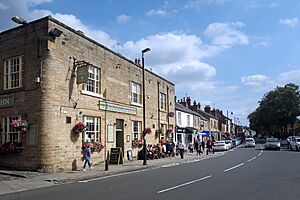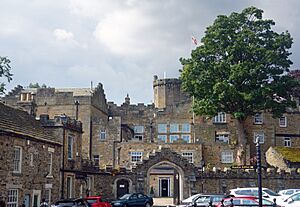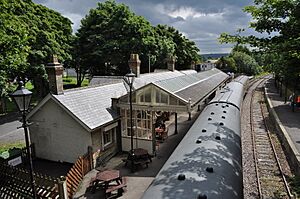Stanhope, County Durham facts for kids
Quick facts for kids Stanhope |
|
|---|---|
| Town | |
 Front Street |
|
| Population | 1,633 (2001 census) |
| OS grid reference | NY995395 |
| Civil parish |
|
| District |
|
| Shire county | |
| Region | |
| Country | England |
| Sovereign state | United Kingdom |
| Post town | Bishop Auckland |
| Postcode district | DL13 |
| Dialling code | 01388 |
| Police | Durham |
| Fire | County Durham and Darlington |
| Ambulance | North East |
| EU Parliament | North East England |
| UK Parliament |
|
Stanhope is a lovely market town and a local area called a civil parish in County Durham, England. It sits by the River Wear, between the villages of Eastgate and Frosterley. You can find it in the north-east part of Weardale. A main road, the A689 road, crosses the Pennines here. Another road, the B6278, also goes through Stanhope. In 2011, about 1,602 people lived in the main built-up area of Stanhope. The wider parish area had a population of 4,581 people.
Contents
About Stanhope's Local Government
|
Stanhope
|
|
|---|---|
|
Civil parish
|
|

Stanhope Castle
|
|
| Country | England |
| Primary council | County Durham |
| County | Durham |
| Status | Civil parish |
| Settlements | Stanhope, Bollihope, Bridge End, Brotherlee, Copthill, Cornriggs, Cowshill, Crawleyside, Daddry Shield, East Blackdene, Eastgate, Frosterley, Hill End, Ireshopeburn, Killhope, Lanehead, Lintzgarth, New House, Rookhope, Shittlehope, St John's Chapel, Unthank, Wearhead, West Blackdene, Westgate and White Kirkley |
| Area | |
| • Total | 85 sq mi (221 km2) |
| Population
(2011)
|
|
| • Total | 4,581 |
| • Density | 53.69/sq mi (20.73/km2) |
| Postcode |
DL13
|
The Stanhope parish is the largest local area of its kind in England. It covers about 221 square kilometers (85 square miles). This area is so big that if it were a separate district, it would be one of the largest in England! Stanhope also shares some land with the nearby Wolsingham parish. The Stanhope Town Hall was finished in 1849 and is an important building in the town.
What to See and Do in Stanhope
Stanhope is surrounded by beautiful moorland. This area is part of the North Pennines Area of Outstanding Natural Beauty (AONB). It's the second largest of these special natural areas in England and Wales.
Here are some interesting things to see in Stanhope:
- A petrified tree stump stands in the churchyard. This means it has turned into stone over a very long time. Two other similar stumps were found nearby. One of them is now in the Great North Museum in Newcastle upon Tyne.
- The Durham Dales Centre is a great place to visit. It has a tea room, a tourist information office, and shops selling local crafts.
- Stanhope Bridge is a very old bridge. It was built in the 1400s and made wider in 1792. It's now a protected historical site.
- The town has a ford, which is a shallow place to cross a river. For people walking, there's a special bridge made of stepping stones.
- Stanhope Castle is in the middle of town. It was built in 1798 by Cuthbert Rippon, who was a Member of Parliament. Some people think a much older castle might have stood there before.
- Stanhope has one of only two heated outdoor swimming pools in the whole North East region.
Stanhope's History and Castle
Stanhope was important during the Weardale campaign in 1327. This was when Sir James Douglas from Scotland invaded England. He faced off against King Edward III and Roger Mortimer. There were several small battles in the valley and in Stanhope Park.
The local church, dedicated to St Thomas, was mostly built between the 1100s and 1200s. It was repaired in 1663 and 1867. One famous person who was a priest here was Joseph Butler in 1725. He later became a Bishop.
Stanhope Castle might have been built on the site of an even older castle. The current castle was built for Cuthbert Rippon in 1798. His son, also named Cuthbert, added more parts to it in 1823. The architect for the castle was Ignatius Bonomi. In 1941, the castle was used as a school for boys. It stayed a school until 1980, when it was turned into apartments. Some of its gardens are across the main road, including a park wall and a small building called a gazebo.
Stanhope Agricultural Show
The Stanhope Agricultural Show is a big event held every year. It takes place on the second weekend of September. This show has been happening since 1834! It was only stopped during the world wars, the 2001 foot-and-mouth disease outbreak, and when the weather was very bad.
Weardale Railway
Stanhope is the end point of the Weardale Railway. This is a special heritage railway line that runs mostly on weekends. It starts in Bishop Auckland and stops at stations like Frosterley, Wolsingham, and Witton-le-Wear. The Stanhope railway station was even used in an episode of the TV show Vera!
Famous People From Stanhope
Here are some notable people who have lived in or were connected to Stanhope:
- Joseph Butler (1692–1752) was a well-known religious thinker and priest.
- William Greenwell (1820–1918) was an archaeologist and priest. He studied ancient finds near Stanhope in the 1800s.
- William Percival Crozier (1879–1944) was a scholar and journalist. He was the editor of the Manchester Guardian newspaper from 1932 to 1944.
- Muriel Young (1923–2001) was a television presenter and producer. She passed away in Stanhope.
Images for kids
See also
 In Spanish: Stanhope (Durham) para niños
In Spanish: Stanhope (Durham) para niños









